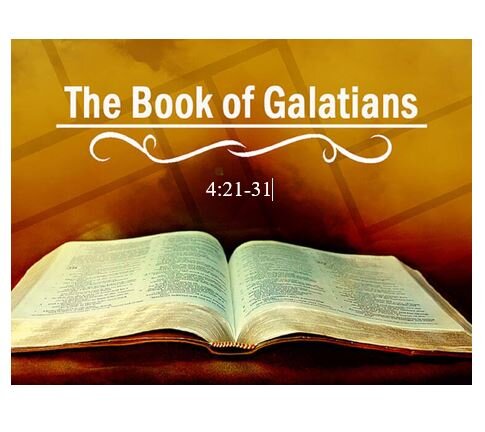BIG IDEA:
THE OT ALLEGORY OF ISHMAEL AND ISAAC PICTURES OUR FREEDOM — ACCOMPLISHED BY THE SPIRIT ACCORDING TO GOD’S PROMISE
(:21) INTRODUCTION – Pay attention to the OT allegory in order to see the absurdity of your inconsistency.
“Tell me, you who want to be under law, do you not listen to the law?”
I. (:22-27) THE KEY DISTINCTIONS IN THE OT ALLEGORY REGARDING ABRAHAM’S TWO SONS = ISHMAEL AND ISAAC
SETTING THE STAGE:
“For it is written that Abraham had two sons”
“This is allegorically speaking”
A. (:22) The Distinction in the Social Position of the Mother
1. Slave — “one by the bondwoman”
2. Free — “one by the free woman”
B. (:23) The Distinction in the Divine Initiative — (Resulting in a Difference in the Faith Approach on the part of the parents)
1. Human Plotting
“But the son by the bondwoman was born according to the flesh”
2. Divine Promise
“and the son by the free woman through the promise”
Piper: ” Isaac was not born according to the flesh because his birth was the result of God’s supernatural intervention in fulfillment of his own promise. Abraham had learned his lesson: the only acceptable response to God’s merciful promise is trust in that promise, not works of the flesh that try, to bring down God’s blessing with our efforts…
Abraham and Hagar tried to get God’s promised blessing by their own strength without relying on God’s supernatural enablement. That is just what happened when the law was given at Mt. Sinai. Instead of humbling themselves and trusting God for help to obey his commands Israel says confidently, ‘All the words which the Lord has spoken we will do’ (Ex. 24:3; Deut. 5:27). But they did not have hearts inclined to trust in God (Heb. 4:2) or truly depend on him (Deut. 5:29). And so like Hagar and Abraham they depended on their own resources.
Our real life is not, like Ishmael’s, simply owing to the work of man. Our real life is owing to the work of God in us fulfilling his promise to make for himself a people (Gen. 12:1-3) and to put his Spirit within them (Ezek. 36:27) and write his law on their hearts (Jer. 31:33).”
C. (24-27) The Distinction in the Two Covenants — “these women are two covenants”
1. The Old Covenant — fleshly Jerusalem representing bondage to the Law
The Covenant of Law and Works
a. Fleshly Jerusalem = the Source
“one proceeding from Mount Sinai”
b. Issueing in Slavery
“bearing children who are to be slaves”
c. Identified as Hagar =
“she is Hagar”
“this present Jerusalem”
Hendriksen: “Over against ‘the Jerusalem of today’ we might have expected Paul to mention ‘the Jerusalem of the future.’ But he cannot very well do this, for the church, as the sum-total of all believers, here contrasted with carnal Israel, is being gathered even now, though her glorious consummation belongs, indeed, to the future. Not until Christ’s return will she have been brought to completion, to shine forth in all her beauty, to the glory of God Triune.”
2. The New Covenant — spiritual Jerusalem representing freedom
The Covenant of Grace and Faith
a. Spiritual Jerusalem = the Source
“But the Jerusalem above”
b. Issuing in Freedom
“is free”
c. Identified as
“the Jerusalem above”
3. Summary
a. (:25) The Old Covenant — Don’t regress back to this
“Now this Hagar is Mount Sinai in Arabia, and corresponds to the present Jerusalem, for she is in slavery with her children.”
b. (:26) The New Covenant — Embrace this
“But the Jerusalem above is free; she is our mother.”
c. (:27) The Surpassing Blessing of the New Covenant
“For it is written, ‘Rejoice, barren woman who does not bear; Break forth and shout, you who are not in labor; For more are the children of the desolate than of the one who has a husband.”
II. (:28-31) THE KEY APPLICATIONS OF THE OT ALLEGORY REGARDING ABRAHAM’S TWO SONS = ISHMAEL AND ISAAC
A. (:28) Privilege of Promise
“And you brethren, like Isaac, are children of promise.”
B. (:29) Pattern of Persecution
“But as at that time he who was born according to the flesh persecuted him who
was born according to the Spirit, so it is now also.”
C. (:30) Priority of Purification (Putting Away the Old Vestiges of Legalism)
“But what does the Scripture say? ‘Cast out the bondwoman and her son, For the son of the bondwoman shall not be an heir with the son of the free woman.’”
Paul was calling for church discipline to be exercised against the false teaching Judaizers and their heretical adherents.
(:31) CONCLUSION – We have been born to freedom not to bondage.
“So then, brethren, we are not children of a bondwoman, but of the free woman.”

